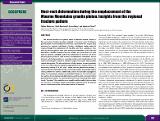Files in this item
Host-rock deformation during the emplacement of the Mourne Mountains granite pluton : insights from the regional fracture pattern
Item metadata
| dc.contributor.author | Mattsson, Tobias | |
| dc.contributor.author | Burchardt, Steffi | |
| dc.contributor.author | Mair, Karen | |
| dc.contributor.author | Place, Joachim | |
| dc.date.accessioned | 2020-11-16T12:30:33Z | |
| dc.date.available | 2020-11-16T12:30:33Z | |
| dc.date.issued | 2020-02-01 | |
| dc.identifier | 271111525 | |
| dc.identifier | 0fe5672b-6e52-477c-8263-e976d4665524 | |
| dc.identifier | 85081082001 | |
| dc.identifier.citation | Mattsson , T , Burchardt , S , Mair , K & Place , J 2020 , ' Host-rock deformation during the emplacement of the Mourne Mountains granite pluton : insights from the regional fracture pattern ' , Geosphere , vol. 16 , no. 1 , pp. 182-209 . https://doi.org/10.1130/GES02148.1 | en |
| dc.identifier.issn | 1553-040X | |
| dc.identifier.other | ORCID: /0000-0003-0717-4014/work/83890079 | |
| dc.identifier.uri | https://hdl.handle.net/10023/20983 | |
| dc.description.abstract | The Mourne Mountains magmatic center in Northern Ireland consists of five successively intruded granites emplaced in the upper crust. The Mourne granite pluton has classically been viewed as a type locality of a magma body emplaced by cauldron subsidence. Cauldron subsidence makes space for magma through the emplacement of ring dikes and floor subsidence. However, the Mourne granites were more recently re-interpreted as laccoliths and bysmaliths. Laccolith intrusions form by inflation and dome their host rock. Here we perform a detailed study of the deformation in the host rock to the Mourne granite pluton in order to test its emplacement mechanism. We use the host-rock fracture pattern as a passive marker and microstructures in the contact-metamorphic aureole to constrain large-scale magma emplacement-related deformation. The dip and azimuth of the fractures are very consistent on the roof of the intrusion and can be separated into four steeply inclined sets dominantly striking SE, S, NE, and E, which rules out pluton-wide doming. In contrast, fracture orientations in the northeastern wall to the granites suggest shear parallel to the contact. Additionally, contact-metamorphic segregations along the northeastern contact are brecciated. Based on the host-rock fracture pattern, the contact aureole deformation, and the north-eastward-inclined granite-granite contacts, we propose that mechanisms involving either asymmetric "trap-door" floor subsidence or laccolith and bysmalith intrusion along an inclined or curved floor accommodated the emplacement of the granites and led to deflection of the northeastern wall of the intrusion. | |
| dc.format.extent | 28 | |
| dc.format.extent | 12791231 | |
| dc.language.iso | eng | |
| dc.relation.ispartof | Geosphere | en |
| dc.subject | QE Geology | en |
| dc.subject | Geology | en |
| dc.subject | Stratigraphy | en |
| dc.subject | DAS | en |
| dc.subject.lcc | QE | en |
| dc.title | Host-rock deformation during the emplacement of the Mourne Mountains granite pluton : insights from the regional fracture pattern | en |
| dc.type | Journal article | en |
| dc.contributor.institution | University of St Andrews. School of Earth & Environmental Sciences | en |
| dc.identifier.doi | https://doi.org/10.1130/GES02148.1 | |
| dc.description.status | Peer reviewed | en |
This item appears in the following Collection(s)
Items in the St Andrews Research Repository are protected by copyright, with all rights reserved, unless otherwise indicated.

